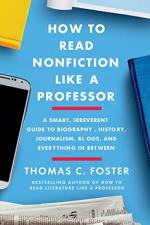
|
| Name: _________________________ | Period: ___________________ |
This quiz consists of 5 multiple choice and 5 short answer questions through Section 2: Chapter 5, "It May Just Be Me, But..." through Chapter 8, "Bringing the News".
Multiple Choice Questions
1. In Chapter 2, "The Ecology of the Nonfiction Biosphere," what does Foster say is true of the sports section?
(a) It contains every type of writing found in a newspaper.
(b) It excludes features.
(c) It contains primarily editorial columns.
(d) Its box scores are an example of soft news.
2. In Chapter 4, "The Parts You Don't Read," what is a piece of information that Foster says we can infer from the notes?
(a) The intended audience.
(b) The author's education.
(c) The author's purpose.
(d) Potential biases.
3. In Chapter 5, "It May Just Be Me, But..." what does Foster say is usually the difference between quoted anonymous sources and sources speaking "on background"?
(a) The only difference is actually whether the information is quoted or paraphrased.
(b) Background sources tend to be highly-placed officials, while anonymous sources tend to be leakers.
(c) Quoted anonymous sources are more likely to be accurate than information obtained "on background."
(d) Reporters are not usually asked to verify information obtained in a quote, but they are supposed to double-check information given "on background."
4. In Chapter 2, "The Ecology of the Nonfiction Biosphere," Foster notes that the expectation for a writer to be engaging does not apply to which types of writing?
(a) Technical.
(b) Academic.
(c) Political.
(d) Informational.
5. In Chapter 2, "The Ecology of the Nonfiction Biosphere," Foster calls an expression a "bromide." What is he saying about this expression?
(a) It is clever and concise.
(b) It is insightful but wordy.
(c) It is boring and mean-spirited.
(d) It is unoriginal and unimportant.
Short Answer Questions
1. In Chapter 7, "All in How You Look at Things," Foster makes what point about newspaper articles?
2. In Chapter 4, "The Parts You Don't Read," what part of a text does Foster say is "under-read"? (39).
3. In Chapter 2, "The Ecology of the Nonfiction Biosphere," where does Foster say editorial content can usually be found in the newspaper?
4. According to "The Building Blocks of Arguments," what are the "grounds" of a argument?
5. In Chapter 8, "Bringing the News," what reason does Foster give for journalists generally being proved correct despite public mistrust?
|
This section contains 430 words (approx. 2 pages at 300 words per page) |

|




